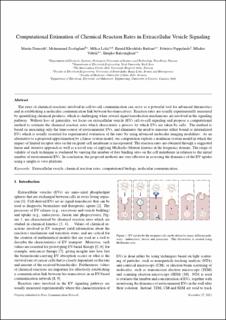| dc.contributor.author | Damrath, Martin | |
| dc.contributor.author | Zoofaghari, Mohammad | |
| dc.contributor.author | Lekic, Milica | |
| dc.contributor.author | Rudsari, Hamid Khoshfekr | |
| dc.contributor.author | Pappalardo, Fabrizio | |
| dc.contributor.author | Veletic, Mladen | |
| dc.contributor.author | Balasingham, Ilangko | |
| dc.date.accessioned | 2024-01-09T09:11:17Z | |
| dc.date.available | 2024-01-09T09:11:17Z | |
| dc.date.created | 2023-05-30T09:15:52Z | |
| dc.date.issued | 2023 | |
| dc.identifier.citation | Nano Communication Networks. 2023, 37 . | en_US |
| dc.identifier.issn | 1878-7789 | |
| dc.identifier.uri | https://hdl.handle.net/11250/3110509 | |
| dc.description.abstract | The rates of chemical reactions involved in cell-to-cell communication can serve as a powerful tool for advanced theranostics and in establishing a molecular communication link between bio-transceivers. Reaction rates are usually experimentally measured by quantifying chemical products, which is challenging when several signal transduction mechanisms are involved in the signaling pathway. Without loss of generality, we focus on extracellular vesicle (EV) cell-to-cell signaling and propose a computational method to estimate the chemical reaction rates which characterize a process by which EVs are taken by cells. The method is based on measuring only the time-course of environmental EVs, and eliminates the need to measure either bound or internalized EVs which is usually essential for experimental evaluation of the rates by using advanced molecular imaging modalities. As an alternative to a proposed approximation by a linear system model, our computation exploits a nonlinear system model in which the impact of limited receptor sites on the recipient cell membrane is incorporated. The reaction rates are obtained through a suggested linear and iterative approach as well as a novel way of applying Michaelis–Menten kinetics in the frequency domain. The range of validity of each technique is evaluated by varying the number of free binding sites on the cell membrane in relation to the initial number of environmental EVs. In conclusion, the proposed methods are very effective in assessing the dynamics of the EV uptake using a simple in vitro platform. | en_US |
| dc.language.iso | eng | en_US |
| dc.publisher | Elsevier | en_US |
| dc.rights | Navngivelse 4.0 Internasjonal | * |
| dc.rights.uri | http://creativecommons.org/licenses/by/4.0/deed.no | * |
| dc.title | Computational estimation of chemical reaction rates in extracellular vesicle signaling | en_US |
| dc.title.alternative | Computational estimation of chemical reaction rates in extracellular vesicle signaling | en_US |
| dc.type | Peer reviewed | en_US |
| dc.type | Journal article | en_US |
| dc.description.version | acceptedVersion | en_US |
| dc.source.pagenumber | 0 | en_US |
| dc.source.volume | 37 | en_US |
| dc.source.journal | Nano Communication Networks | en_US |
| dc.identifier.doi | 10.1016/j.nancom.2023.100455 | |
| dc.identifier.cristin | 2150038 | |
| cristin.ispublished | true | |
| cristin.fulltext | postprint | |
| cristin.qualitycode | 1 | |

